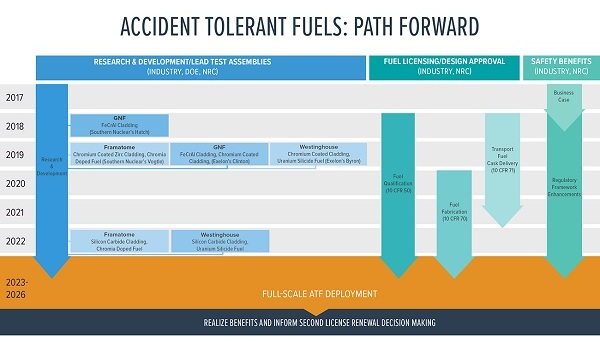Following a planned outage, Unit 1 at the Edwin I. Hatch Nuclear Plant near Baxley in southeastern Georgia returned to service in early March outfitted with first-of-their-kind accident tolerant fuel (ATF) test assemblies.
The development marks a major milestone for the advanced fuel technology, which, beyond safety benefits, could furnish the world’s light water reactor fleet with much-needed cost efficiencies to help them stay competitive.
For the next 24 months until its next refueling outage, Unit 1, a 1975-built General Electric (GE) boiling water reactor rated at 924 MW, will test iron-chromium-aluminum fuel cladding material known as “IronClad” and coated zirconium fuel cladding known as “ARMOR.” According to Southern Nuclear Operating Co., which operates the two-unit Plant Hatch, the ATF technologies have “industry-changing safety and efficiency advantages” that could make plants safer and result in more operational flexibility. That’s why the installation at Plant Hatch, the first of its kind at a commercial nuclear facility, “is not a small step, but a leap for our industry,” said Southern Nuclear’s Nuclear Fuel Director John Williams.
“An accident-tolerant fuel is an industry term used to describe new technologies that further enhance the safety and performance of nuclear materials. This can be in the form of new cladding and/or fuel pellet designs,” explained Edward McGinnis, principal deputy assistant secretary for the Office of Nuclear Energy at the U.S. Department of Energy (DOE), in February.

The concept isn’t new: ATF technologies have been under development since the early 2000s. However, it received a marked boost in the wake of the Fukushima accident in March 2011 as the DOE aggressively implemented plans under its congressionally mandated Enhanced Accident Tolerant Fuel (EATF) program to develop ATFs for existing light water reactors. The program today casts a wide net of collaboration that includes several U.S. utilities, universities, and the Electric Power Research Institute.
To date, three concepts for advanced ATF fuels—including fuel pellet and cladding materials—are under development and qualification by GE’s Global Nuclear Fuel (GNF), AREVA, and Westinghouse, with funding and technical backing from the DOE and its national labs. Burlington, Massachusetts-based Lightbridge is developing its own advanced metallic fuel concept, exploring zirconium-alloy cladding and a metallic uranium alloy, with potential accident tolerant characteristics. The DOE-backed concepts, at least, could come to market within the next 10 years, McGinnis suggested.
Installation of GNF’s IronClad and ARMOR pilot test assemblies at Plant Hatch lead the ATF pack for now, but more developments, as groundbreaking, are on the horizon.
The IronClad assemblies (Figure 2) are based on a technology developed by GNF in cooperation with Oak Ridge National Laboratory, which essentially uses a combination of iron, chromium, and aluminum for its fuel cladding to improve the fuel’s behavior under severe accident scenarios. “The steel material has a much lower oxidation rate when exposed to high temperature steam,” said McGinnis. “This improves the safety margins at higher temperatures over traditional zirconium cladding used today.”
GNF, which shipped the test assemblies to Plant Hatch in early 2018, said the IronClad assemblies include two variations of the iron-chromium-aluminum material. “One material will be in fuel rod form but will not be fueled, while the other material is in the form of a solid bar segment,” it said. The ARMOR lead test assemblies, which the company developed outside the DOE’s program, contains standard zirconium fuel rods coated with ARMOR coating to provide debris resistance and more oxidation resistance than standard zirconium cladding.
GNF CEO Amir Vexler in a February statement said that the ferritic steel and coated zirconium cladding are just some of many technologies GNF is exploring as part of its advanced fuel portfolio, but they are best poised to be brought into the market in the near term to provide myriad benefits. Beyond Plant Hatch, GNF also plans to test IronClad and ARMOR cladding material at Exelon Generation’s Clinton Power Station in 2019.
The IronClad assemblies (Figure 2) are based on a technology developed by GNF in cooperation with Oak Ridge National Laboratory, which essentially uses a combination of iron, chromium, and aluminum for its fuel cladding to improve the fuel’s behavior under severe accident scenarios. “The steel material has a much lower oxidation rate when exposed to high temperature steam,” said McGinnis. “This improves the safety margins at higher temperatures over traditional zirconium cladding used today.”
GNF, which shipped the test assemblies to Plant Hatch in early 2018, said the IronClad assemblies include two variations of the iron-chromium-aluminum material. “One material will be in fuel rod form but will not be fueled, while the other material is in the form of a solid bar segment,” it said. The ARMOR lead test assemblies, which the company developed outside the DOE’s program, contains standard zirconium fuel rods coated with ARMOR coating to provide debris resistance and more oxidation resistance than standard zirconium cladding.
GNF CEO Amir Vexler in a February statement said that the ferritic steel and coated zirconium cladding are just some of many technologies GNF is exploring as part of its advanced fuel portfolio, but they are best poised to be brought into the market in the near term to provide myriad benefits. Beyond Plant Hatch, GNF also plans to test IronClad and ARMOR cladding material at Exelon Generation’s Clinton Power Station in 2019.
































